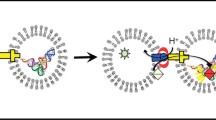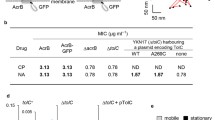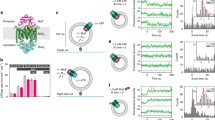Abstract
Proteins are constantly synthesized and degraded in living cells during their growth and division, often in response to metabolic and environmental conditions. The synthesis and breakdown of proteins under different conditions reveal information about their mechanism of function. The metabolic incorporation of non-natural amino acid azidohomoalanine (AHA) and subsequent labeling via click chemistry emerged as a non-radioactive strategy useful in the determination of protein kinetics and turnover. We used the method to monitor the degradation of two proteins involved in the multidrug efflux in Escherichia coli, the inner membrane transporter AcrB and its functional partner membrane fusion protein AcrA. Together they form a functional complex with an outer membrane channel TolC to actively transport various small molecule compounds out of E. coli cells. We found that both AcrA and AcrB lasted for approximately 6 days in live E. coli cells, and the stability of AcrB depended on the presence of AcrA but not on active efflux. These results lead to new insight into the multidrug resistance in Gram-negative bacteria conferred by efflux.





Similar content being viewed by others
References
Goldberg A, ST. John A. Annu Rev Biochem. 1976;45:747–803.
Mayer R, Doherty F. FEBS Lett. 1986;198:181–93.
Dice JF. FASEB J. 1987;1:349–57.
Simon E, Kornitzer D. Methods Enzymol. 2014;536:65–75.
Martell J, Weerapana E. Molecules. 2014;19:1378–93.
Avti PK, Maysinger D, Kakkar A. Molecules. 2013;18:9531–49.
Hatzenpichler R, Scheller S, Tavormina PL, Babin BM, Tirrell DA, Orphan VJ. Environ Microbiol. 2014;16:2568–90.
Dieck ST, Kochen L, Hanus C, Heumüller M, Bartnik I, Nassim-Assir B, et al. Nat Methods. 2015;12:411–4.
Link AJ, Tirrell DA. J Am Chem Soc. 2003;125:11164–5.
Simon M, Stefan N, Borsig L, Pluckthun A, Zangemeister-Wittke U. Mol Cancer Ther. 2014;13:375–85.
McClatchy DB, Ma YH, Liu C, Stein BD, Martinez-Bartolome S, Vasquez D, et al. J Proteome Res. 2015;14:4815–22.
Dieterich DC, Hodas JJL, Gouzer G, Shadrin IY, Ngo JT, Triller A, et al. Nat Neurosci. 2010;13:897–905.
Deal RB, Henikoff JG, Henikoff S. Science. 2010;328:1161–4.
Hiroshi N, Yumiko R. Biochim Biophys Acta, Proteins Proteomics. 2009;1794:769–81.
Koronakis V, Eswaran J, Hughes C. Annu Rev Biochem. 2004;73:467–89.
Li XZ, Poole K, Nikaido H. Antimicrob Agents Chemother. 2003;47:27–33.
Lu W, Zhong M, Wei Y. Protein Pept Lett. 2011;18:863–71.
Lu W, Chai Q, Zhong M, Yu L, Fang J, Wang T, et al. J Mol Biol. 2012;423:123–34.
Link AJ, Vink MK, Tirrell DA. J Am Chem Soc. 2004;126:10598–602.
Chai Q, Wang Z, Webb S, Dutch RE, Wei Y. Biochemistry. 2016;5:2301–4.
Hinz FI, Dieterich DC, Tirrell DA, Schuman EM. ACS Chem Neurosci. 2012;3:40–9.
Rostovtsev VV, Green LG, Fokin VV, Sharpless KB. Angew Chem Int Ed Engl. 2002;41:2596–9.
Rosenberg EY, Bertenthal D, Nilles ML, Bertrand KP, Nikaido H. Mol Microbiol. 2003;48:1609–19.
Su CC, Li M, Gu R, Takatsuka Y, McDermott G, Nikaido H, et al. J Bacteriol. 2006;188:7290–6.
Belle A, Tanay A, Bitincka L, Shamir R, O’Shea EK. Proc Natl Acad Sci U S A. 2006;103:13004–9.
Cambridge SB, Gnad F, Nguyen C, Bermejo JL, Krüger M, Mann M. J Proteome Res. 2011;10:5275–84.
Yen HC, Xu Q, Chou DM, Zhao Z, Elledge SJ. Science. 2008;322:918–23.
Willetts NS. Biochem J. 1967;103:453–61.
Koch AL, Levy HR. J Biol Chem. 1955;217:947–57.
Luscombe M, Phelps CF. Biochem J. 1967;102:110–9.
Borek E, Ponticorvo L, Rittenberg D. Proc Natl Acad Sci U S A. 1958;44:369–74.
Larrabee KL, Phillips JO, Williams GJ, Larrabee AR. J Biol Chem. 1980;255:4125–30.
Acknowledgments
This work was supported by the National Science Foundation (MCB 1158036, YW) and National Institute of Allergy and Infectious Diseases (1R21AI103717, YW; R01 AI051517, RED; and F31 fellowship AI120653-01, SRW). The funders had no role in study design, data collection and analysis, decision to publish, or preparation of the manuscript.
Author information
Authors and Affiliations
Corresponding author
Ethics declarations
Conflicts of interest
The authors declare that they have no potential conflicts of interest.
Electronic supplementary material
Below is the link to the electronic supplementary material.
ESM 1
(PDF 197 kb)
Rights and permissions
About this article
Cite this article
Chai, Q., Webb, S.R., Wang, Z. et al. Study of the degradation of a multidrug transporter using a non-radioactive pulse chase method. Anal Bioanal Chem 408, 7745–7751 (2016). https://doi.org/10.1007/s00216-016-9871-7
Received:
Revised:
Accepted:
Published:
Issue Date:
DOI: https://doi.org/10.1007/s00216-016-9871-7




